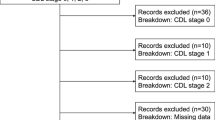Abstract
Objective
To present the motor deficits and type of neurogenic bladder dysfunction (NBD) in patients with vertebral fractures at thoracolumbar junction.
Methods
Fifty-two patients with single level vertebra fracture over T11–L2 with onset duration of longer than 3 years were enrolled. All participants provided basic demographic data, ambulatory status and received neurologic examination and urodynamic studies. The differences in distribution of NBD types, neurologic injury sites and functional walkers in patients with different levels of vertebral injury were analyzed. Receiver operating characteristic curve analysis was used to define the cutoff value of lower extremities motor score (LEMS) in functional walker and non-walker.
Results
Of the 52 patients, the injured levels were 3 (5.8%) in T11, 21 (40.4%) in T12, 22 (42.3%) in L1, and 6 (11.5%) in L2 vertebrae. Eight (15.4%) patients had upper lumbar cord lesions, 26 (50.0%) had epiconus and lumbar roots lesions, 18 (34.6%) had conus medullaris or/and cauda equina lesions. Mean LEMS was 0 ± 0, 5.4 ± 7.7, 11.1 ± 10.2, and 28.0 ± 11.0 for patients with T11, T12, L1, and L2 fractures, respectively. Patients with L2 fractures had higher LEMS than other levels (p < 0.001). The cutoff value of LEMS for functional walking was set at 20, and both the sensitivity and specificity was 100%. Thirty-one (59.6%) patients had spastic NBD, 18 (35.6%) had flaccid NBD, and 3 (5.8%) had mixed type NBD. Positive prediction value of ankle spasticity for bladder and sphincter spasticity was 95.2 and 100%, respectively.
Conclusion
Half of the patients had epiconus lesion following thoracolumbar junction fracture, and they had a clinical presentation of flaccid legs and spastic NBD. Patients with L2 fracture had higher LEMS than patients with T11, T12, and L1 fracture. Patients whose LEMS was higher than 20 could all walk functionally. Fracture at the thoracolumbar junction may cause spastic, flaccid, or mixed type NBD, and urodynamic study is an essential tool for the correct diagnosis and management. Ankle spasticity has a high positive predictive value for spastic bladder or sphincter.

Similar content being viewed by others
Abbreviations
- NBD:
-
Neurogenic bladder dysfunction
- LEMS:
-
Lower extremity motor score
- T:
-
Thoracic
- L:
-
Lumbar
- S:
-
Sacral
- SCI:
-
Spinal cord injury
- MRI:
-
Magnetic resonance imaging
- ASIA:
-
American Spinal Injury Association
References
Go BK, DeVivo MJ, Richards JS (1995) The epidemiology of spinal cord injury. In: Stover SL, Delisa JA, Whiteneck GG (eds) Spinal cord injury: clinical outcomes from the model system. Aspen Publishers, Gaithersburg, pp 87–103
Holmes JF, Miller PQ, Panacek EA, Lin S, Horne NS, Mower WR (2001) Epidemiology of thoracolumbar spine injury in blunt trauma. Acad Emerg Med 8:866–872
Scher AT (1983) Radiological assessment of thoracolumbar spinal injuries. S Afr Med J 64:384–387
Levine AM (1998) Classification of spinal injury. In: Levine AM, Eismont FJ, Garfin SR, Zigler JE (eds) Spine trauma. W.B. Saunders Company, Philadelphia, pp 113–132
Saifuddin A, Burnett SJD, White J (1998) The variation of position of the conus medullaris in an adult population. Spine 23:1452–1456
Soleiman J, Demaerel P, Rocher S, Maes F, Marchal G (2005) Magnetic resonance imaging study of the level of termination of the conus medullaris and the thecal sac: influence of age and gender. Spine 30:1875–1880
Doherty JG, Burn AS, O’Ferrall DM, Ditunno JF Jr (2002) Prevalence of upper motor neuron vs lower motor neuron lesions in complete lower thoracic and lumbar spinal cord injuries. J Spinal Cord Med 25:289–292
Sie I, Waters RL (2003) Outcomes following spinal cord injury. In: Lin VW et al. (eds) Spinal cord medicine: principles and practice, Chap 5. Demos Publishing Co., New York, pp 87–103
Ditunno PL, Patrick M, Stineman M, Ditunno JF (2008) Who wants to walk? Preferences for recovery after SCI: a longitudinal and cross-sectional study. Spinal Cord 46:500–506
Scivoletto G, Di Donna V (2009) Prediction of walking recovery after spinal cord injury. Brain Res Bull 78:43–51
Scivoletto G, Romanelli A, Mariotti A, Marinucci D, Tamburella F, Mammone A, Xosentino E, Sterzi S, Molinari M (2008) Clinical factors that affect walking level and performance in chronic spinal cord lesion patients. Spine 33:259–264
Waters RL, Yakura JS, Adkins R, Barnes G (1989) Determinants of gait performance following spinal cord injury. Arch Phys Med Rehabil 70:811–818
Kirshblum S, Donovan W (2002) Neurological assessment and classification of traumatic spinal cord injury. In: Kirshblum S (ed) Spinal cord medicine. Lippincott Williams & Wilkins, Philadelphia, pp 82–95
Willems J, Chappel R (1997) The epiconus syndrome presenting radicular-type neurological features. Spinal Cord 35:709–710
Waters RL, Adkins R, Yakura J, Vigil D (1994) Prediction of ambulatory performance based on motor scores derived from standards of the American Spinal Injury Association. Arch Phys Med Rehabil 75:756–760
Linsenmeyer TA (2002) Neurogenic bladder following spinal cord injury. In: Kirshblum S (ed) Spinal cord medicine. Lippincott Williams & Wilkins, Philadelphia, pp 181–205
Bors E (1957) Neurogenic bladder. Urol Surv 7:177–250
Pesce F, Castellano V, Agro EF, Gionnantoni A, Tamburro F, Vespasiani G (1997) Voiding dysfunction in patients with spinal cord lesions at the thoracolumbar vertebral junction. Spinal Cord 35:37–39
Weld KJ, Dmochowski RR (2000) Association of level of injury and bladder behavior in patients with post-traumatic spinal cord injury. Urology 55:490–494
Conflict of interest
None.
Author information
Authors and Affiliations
Corresponding author
Rights and permissions
About this article
Cite this article
Chen, SL., Huang, YH., Wei, TY. et al. Motor and bladder dysfunctions in patients with vertebral fractures at the thoracolumbar junction. Eur Spine J 21, 844–849 (2012). https://doi.org/10.1007/s00586-011-2062-5
Received:
Revised:
Accepted:
Published:
Issue Date:
DOI: https://doi.org/10.1007/s00586-011-2062-5




